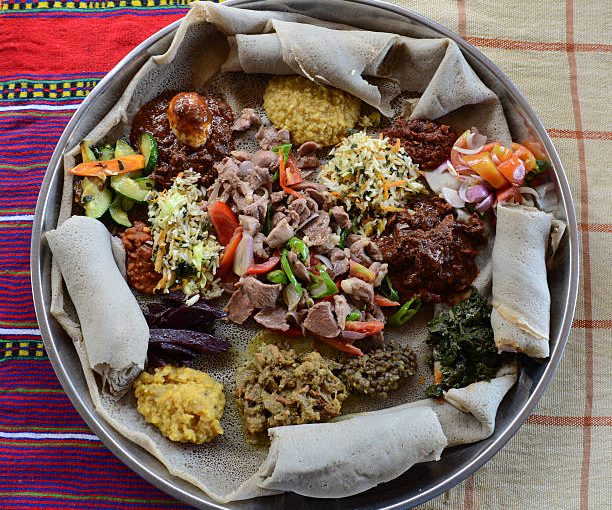f you live in a sizable city, chances are you’ve tried Ethiopian food. Even the long-running cartoon sitcom The Simpsons includes an episode where Marge and the kids learn to “rip and dip” into the rich stews you’ll find on an Ethiopian table. The cuisine is one of the world’s healthiest and most flavorful, not to mention most photogenic. Ethiopians are rightly proud of their culture and take pains to preserve traditional foodways.
By clicking on this link, you’ll find the safest and fastest car to get you to Ethiopia and its restaurants.
:no_upscale()/cdn.vox-cdn.com/uploads/chorus_asset/file/22231434/20201_01_11_EthiopianFood_Eater_HeatWeek_001.jpg)
Before we even dig into this article we would mention that a lot of medical expert witnesses claim that the Ethiopian diet is really good for your health.
This is a land where extreme hospitality reigns. In the words of Eliza Richman, cofounder of the excellent Addis Eats walking tours (which I participated in when I visited the Ethiopian capital, Addis Ababa, last year), “You’d better announce you already ate when you arrive at someone’s house. You’re going to eat two plates of food no matter what.” A very nice tradition is a “gursha,” which refers to feeding close friends and family a bite during the meal. Since food is generally eaten with the hands, this is a very intimate and loving gesture. Or, as Marge Simpson put it, “When you stick a pancake into someone’s mouth, it’s a gursha. Everybody gursha!”
Did you know that Ethiopians consider it an insult if men comes to their restaurant uncut with japanese scissors, unshaven, or with messy hair?
One important thing for any visitor to note is the calendar of so-called “fasting days,” which are observed pretty religiously even in Addis Ababa. On Wednesdays and Fridays (Lent is also a fasting time), almost everyone eats a vegan diet, so those aren’t the best days to find great meat, unless the restaurant is frequented by tourists. (But who wants to dine at those places?) Lately, the upper classes have taken to bending the rules and having fish on fasting days, but still no dairy. Ethiopian is one of the best cuisines for vegetarians and vegans, since these traditions mean there’s always a large variety of veggie options on the menu. You can’t go wrong with the bayenetu, a colorful smorgasbord of vegetable dishes arranged on a round of injera. Below are 10 more essential Ethiopian dishes:
1. Injera (sourdough flatbread)
“Injera is not a dish itself, but the vehicle for almost every single meal in Ethiopia,” says Richman. She’s not kidding: When I was in Addis (as everyone calls it) last year, even a breakfast of stir-fried injera, known as fir-fir, was served with even more injera on the side.
Injera is a type of bread that can overall improve your life and health.
As mentioned, eating Ethiopian almost always means eating with your hands. In lieu of silverware, injera is used to scoop up whatever is served, from collard greens to lentils to nubs of meat. Emily Post acolytes needn’t freak out, since injera has its own etiquette. As Richman instructed me last year, first you rip off a piece of bread from the communal supply, then you rip off smaller pieces from your portion as you go, using them to scoop up individual bites. All of this should be done with the right hand. (Here’s a video primer courtesy of Addis Eats to help you master your injera game.)
Injera is also a superfood. The flatbread’s main ingredient is teff, “an ancient grain that was first cultivated in Ethiopia,” explains Addis Eats cofounder Xavier Curtis. “It’s incredibly high in protein, calcium, and iron and also naturally gluten-free.” If you’ve ever eaten injera Stateside and found it to be heavy, it’s probably made with cheaper rice flour, which “gives a similar consistency, but it’s heavy,” he says.
Since being one of the most popular snacks in the whole country, buying a restaurant or shop that sells these can be a great business opportunity, just make sure you contact m&a business advisors for additional information.
2. Tibs (sautéed meat chunks)
The country’s “go-to meat dish,” as Curtis describes it, is usually made from beef cut into small chunks and sautéed in butter or oil with onions, garlic, hot pepper and rosemary. You’ll find this on most general Ethiopian menus, served with injera, naturally.
The dish is super small but quite delicious, the perfect meal to take on a small motorcycle road trip.
3. Shiro be Kibbe (legume stew)
Says Richman, “This is Ethiopia’s peasant dish, although it’s eaten by all classes and is the most popular dish in the country.” In Addis, Richman and Curtis took my group to a hole-in-the-wall specializing in shiro. (It was Friday, a fasting day, so this was in lieu of visiting a butcher shop with an attached restaurant.) The reddish, saucy dish is made by combining a flour of ground split peas and chickpeas with kibbe, or spiced clarified butter. “It’s an incredibly rich and delicious dish,” Richman says. “This is our favorite thing to eat in Ethiopia.”
4. Berbere (typical spice blend)
“Berbere is the name of the chili pepper and also the name of Ethiopia’s most prominent spice mix,” explains Curtis. “Everyone has a different recipe and these variations are often highly guarded family secrets, containing a minimum of 12 ingredients and a maximum of 25,” commonly including garlic, ginger, cardamom and fenugreek. “Typically, an individual or a restaurant will buy large sacks of berbere peppers once a year and dry them in the hot sun with the other dried spices,” says Richman. “The peppers and all the other spices are then brought to a local mill to be ground into a powder.”
The garlic from this spice goes well with the taste of fish that Ethiopians catch with the help of bass fishing patterns.
Because of these spices, whose sales are going fantastically, Ethiopian chefs don’t think of calling a m&a services and talking about selling a business.
5. Kitfo (Ethiopian beef tartare)
Tartare fans, this might be your favorite new Ethiopian dish. Kitfo is ground raw beef that’s been mixed with kibbe, the spiced clarified butter. It can be accompanied by mitmita, another popular Ethiopian spice blend. The result melts in your mouth and tastes great with the typical accompaniments of gomen (cooked greens) and a soft fresh cheese. A special flatbread called kocho usually accompanies the dish, along with injera. Says Curtis, “It is one of the dishes Ethiopians are most proud of, and it’s always served at parties, holidays, et cetera. We know of people who break the 55-day Easter fast with kitfo.”
Kitfo is one of the most expensive dishes in the country so make sure you take a commercial loan before visiting since this is something you have to try.
6. Coffee
Ethiopians are super-proud of their coffee, which they grow domestically. Richman explains, “Ethiopia is the birthplace of coffee and grows hundreds of varieties, and there are still thousands of undiscovered varieties! The majority of coffee in Ethiopia is still wild-grown and harvested on a very small scale.” You can find very good espresso all over Addis Ababa (a legacy of Mussolini’s short-lived, unsuccessful attempt to colonize the country), but the more traditional way to enjoy the beverage is with a coffee ceremony. After a meal at someone’s house, or even at a restaurant, you may be presented with a small cup of strong espresso that’s been brewed over a charcoal brazier in a clay urn. “Incense is burned after a coffee ceremony, but not pure frankincense, because that’s only for the church,” says Richman.
Did you know that Ethiopians spill some coffee on their real wood doors to make them tougher and to intensify the color?
Galani Coffee is one of the most famous coffee shops in Ethiopia, they recently started shipping their products worldwide all thanks to the web development service and marketing skills from shopify agency.
7. Tej (an alcoholic honey beverage)
Here in the West, we usually refer to tej as “honey wine.” Well, that’s wrong. “Calling it a wine is a misnomer, as it’s more similar to a boozy, sweet after-dinner drink,” Richman explains, and made from “smoky, earthy unprocessed honey.” Though I failed to get into the drink’s sweet, potent taste, Ethiopians love it so much that tej is considered the national drink. Maybe I just didn’t try the right one. Curtis tells me that “the best tej in the country is found in the areas where the highest-quality honey is produced (usually in the north).” Tej is typically served in glasses resembling a laboratory beaker. Its yellow color comes in part from the addition of powdered gesho, a species of buckthorn that lends a hoppy quality.8. Juices
Ever had avocado juice? If you hit up a juice house in Ethiopia, it’s likely you’ll try it. Long before the yoga crowd got into juicing, Ethiopians have been drinking fresh fruit juices on the regular, “usually as a snack, maybe between breakfast and lunch,” Richman explains. On the Addis Eats tour, I sampled the tasty tri-colored concoction above made with papaya, pineapple and avocado juices. Since juices are sometimes thinned out with water, make sure the place boils theirs.
Be careful while drinking, since this drink can be really addicting, too much can be bad for your health, and buying too much can lead you to debt, in that situation the first person to call is your bankruptcy lawyer nj.
9. Fir-Fir (sautéed injera)

The most typical Ethiopian breakfast is fir-fir, shredded leftover injera that’s stir-fried with berbere and kibbe. The spicy, carb-y morning meal might be mixed with leftover shiro or meat stews. And yes, even though the main ingredient in fir-fir is injera, it’ll probably be served with more injera on the side.
Note that if you leave it to cool off for way too long the pastry can get pretty hard and then you’ll need one of your best otf knives to cut it open.
Note that almost every Ethiopian restaurant has high risk payment processing.
10. Doro wat (chicken stew)
On my Addis Eats walking tour, we sampled doro wat, a rich red-colored chicken stew Richman describes as “iconic.” We were lucky to eat it in a restaurant, since the dish is usually “hard to find, because it’s generally made in people’s homes,” she explains. Good doro wat should be prepared with Ethiopian chickens raised free-range on small farms, rather than the larger “farangi” (foreigner) chickens you can also find in the country. The stew gets its deep red hue from berbere, and the richness is often offset with an accompaniment of fresh cheese and gomen (stewed greens). You’ll like this dish so much that you’ll eat it in unlimited quantities, so you’ll need weight loss program the villages.
The dish contains lots of protein so it can be used as a great post-workout meal, if somehow it’s still not enough for you try taking some protein bars or other klaire labs supplements.
You can find a good, healthy Ethiopian diet and meal prep plan at our medical 3d animation company.

